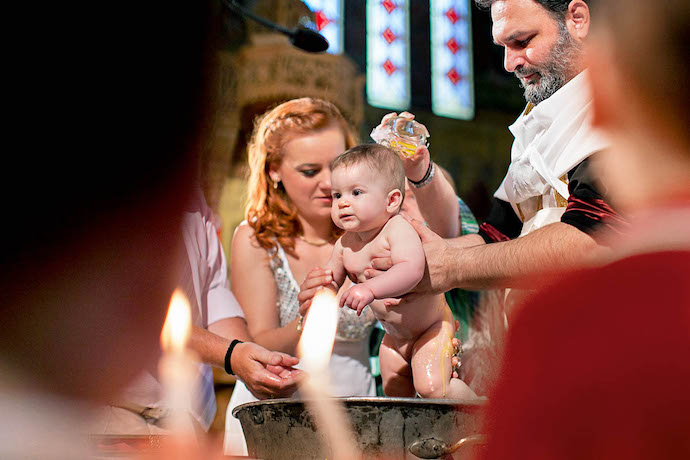Last week a six-week-old baby died in Suceava, Romania during his baptism into the Romanian Orthodox Church. The priest is being held on manslaughter charges and a firestorm of anger has begun to be directed at the Orthodox Church’s practice of full-immersion infant baptism, including a petition urging the Romanian church to change its practice. The Romanian Patriarch has said no such changes will occur.
But neither the incident (no matter how tragic) nor the reaction (no matter how expected) is what I’m interested in here. What interests me is how differently the incident has been reported in the Western media than in traditionally Orthodox countries, and the ways in which this difference reveals the limits of the conversations around decolonization, multiculturalism, and self-determination.
To begin with, why does the Orthodox Church practice the full-immersion baptism of infants? In fact, how and when baptism should occur has been a point of contention and identity within the larger Christian world for at least 1,800 years. Whether or not early Christians practiced infant baptism (paedobaptism is the technical term) is a matter of much debate; in fact, one might argue it’s the debate on which all subsequent discussion of baptism (of which there’s a great deal) is founded.
There is no direct Biblical evidence for infant baptism; however, both Origen and Tertullian, writing in the early to mid 2nd century, describe the practice as customary. We do know that nearly every early Christian community practiced full-immersion baptism. The Greek word βάπτω, from which the word baptism derives, means “to dunk.” Baptism by affusion (that’s the sprinkling of water that you will see in most Western churches, both Catholic and Protestant) initially emerged as a concession, probably in the 2nd century, but ultimately became the standard practice of the Western church by the 10th century. That being said, many Protestant traditions, particularly those who rejected the baptism of infants, eventually returned to full-immersion baptism.
It’s the medieval, pre-Reformation context that’s important here, however. Because like many ancient liturgical practices retained in the East, full-immersion baptism became an important marker of Eastern Christian identity—particularly as increasingly numbers of Eastern Christians became the simultaneous targets of Western crusaders and Islamic conquerors. In this context, rigid adherence to liturgical customs became a means by which to assert and preserve identity in the face of colonization and oppression.
Conversely, adherence to Christian practices abandoned by the Christian West—if not in the Middle Ages then certainly by the early Modern Period—came to symbolize the backwardness and even barbarity of the Christian East and was used to place Eastern Christians and traditionally Eastern Christian cultures outside of the parameters of the “West.” It did not and does not matter that Christianity was a significant pillar around which “Western” identity was built. Eastern Christians simply came to be seen as somehow not fully Christian. Nor did it seem to faze anyone that ancient Greek culture was heralded as the mythic ancestor of the West, while modern Greeks, nearly all at least cultural Orthodox Christians, were (and frequently still are) excluded from its shifting borders.
Which brings us back to those Orthodox full-immersion infant baptisms. It should be noted that this is not the first time an Orthodox baptism has caused controversy. The video of a baby being “violently baptized” has circulated on the internet for the past two and half years, complete with the priest in full Orthodox regalia, though no location or priest has ever been identified. Moreover, as the Snopes article on the first video notes, this unidentified video is reminiscent of another video, of a mass infant baptism in Georgia, which also elicited controversy, predominately in Western Europe and North America. The Snopes article concludes, “…it’s clear that the baptismal practice depicted isn’t all that uncommon.”
And that’s true. Millions of infants have been baptised this way over centuries (including me, by the way). What’s uncommon is for an infant to die, as was the case last week. So what happened? Well, the Romanian, Greek, and Russian press all make note of the fact that the priest baptized the infant face up while holding his hand over the infant’s face and mouth (something observable in the video of the baptism). This is not the position in which infants are ordinarily baptised. And it’s a dangerous difference. Because babies when they are just dunked in water hold their breath. But a baby being placed in the water, face up, with a man’s hand over his face, doesn’t receive the cues and so cannot react naturally.
There’s an explanation as to why this child died and so many others do not, and the Western media were not all interested in reporting this difference. Because for the Western media the main story isn’t the tragedy but the barbarity of these backward Eastern practices. And this is a line of reasoning not much different from that taken by the Crusaders, Ottomans, and Soviets—all of whom worked to eradicate Eastern Christian identity.
This would be easier to see if the culture in question were in Asia or Africa or among the indigenous people of the Americas. But the strange relationship between the West and the Christian East makes it difficult to see, highlighting how limited and reductive the conversation around decolonization and multiculturalism truly is. Because in the ironically binary world that these discourses create, there’s little room for whatever traditionally Orthodox cultures are: European, but not Western; Christian, but not Western. It makes us unable to see that when we hijack a tragedy to assert our cultural superiority we’re engaging in a dangerous game, regardless of the culture. And that nothing looks like it does on a viral video.





